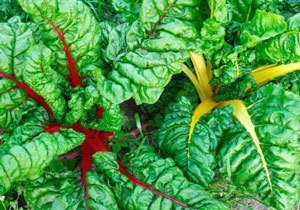
A site receiving full sun is premium real estate in the vegetable garden. If sunny spots are in short supply in your garden, an easy way to free up space, expand your garden (and your yields) is to use the shady spots in your garden to your advantage. A wide range of delicious fruits, vegetables, and herbs can all be grown in partial shade.
In horticulture, partial shade is described as any site that receives 3 to 6 hours of sun per day. Flowering edibles (tomatoes, melons, squash and peppers) need the most amount of sun. They prefer 8 to 10 hours a day. Leafy vegetables, like spinach and lettuce, need only 6 hours of sun a day and tolerate partial shade quite well because they can be picked at any stage of maturity. Partial shade is also good for planting early and late crops (while trees are without leaves) and for crops conducive to succession plantings.
While production and performance will be better in full sun, the following edibles need a minimum of 6 hours of sun a day and are considered tolerant of partial shade. This list is by no means extensive. Experiment and find out what works best for your site.
Plant your partial shade crops in rows from east to west. This will maximize the amount of light they receive by allowing plants of different heights to follow the sun as it passes overhead during the day. Don't cut down whole trees to create more sun, but consider thinning out some of its lower branches to open up some more light.
Keep a careful eye on the moisture levels of your shady crops. You may find you need to water them more often. Shady sites are often more dry than sites receiving full sun, because the roots of trees tend steal all of the moisture from surrounding plants. Trees make a great shelter to stand under when it is raining, unless of course, you are a plant. Plants growing underneath them receive less water because branches divert falling rain toward the outer perimeter of the canopy, where it drips from the branches onto the thirsty roots below.
In partial shade, the roots of hungry trees often gobble soil nutrients up as fast as they become available. Give edibles a boost above their competition by applying a balanced fertilizer in the spring, and one or two more applications as the growing season progresses. An alternative is to consider growing edibles in containers so they don't have to compete at all with neighboring trees and shrubs.

About The Author: Ellen Brown is an environmental writer and photographer and the owner of Sustainable Media, an environmental media company that specializes in helping businesses and organizations promote eco-friendly products and services. Contact her on the web at http://www.sustainable-media.com
Add your voice! Click below to comment. ThriftyFun is powered by your wisdom!
THANK YOU SO MUCH for this information!!! I first had great sun when I moved into my house about 12 years ago - now my beautiful willow tree has grown bigger than God knows what & has completely shaded my entire back yard; nice for coolness - bad for growing anything that needs sun. I was at a loss of what to grow because I love growing everything. Thanks again for this wealth of info!!
Also think about when the vegetables will be growing and the tree patterns of those that are blocking the sun. If some trees don't leaf out until later, you can sneak in more sun. Trimming trees every few years also can help. Here are some tips of making a bed for a vegetable garden -- always a helpful topic.
www.oldhouseweb.com/
Add your voice! Click below to comment. ThriftyFun is powered by your wisdom!